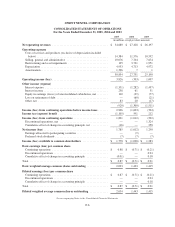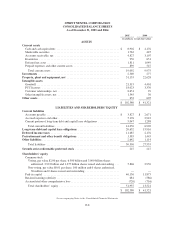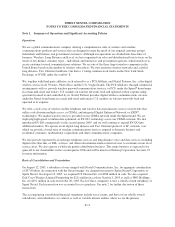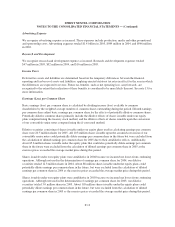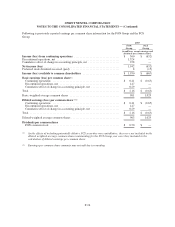Sprint - Nextel 2005 Annual Report Download - page 111
Download and view the complete annual report
Please find page 111 of the 2005 Sprint - Nextel annual report below. You can navigate through the pages in the report by either clicking on the pages listed below, or by using the keyword search tool below to find specific information within the annual report.SPRINT NEXTEL CORPORATION
NOTES TO THE CONSOLIDATED FINANCIAL STATEMENTS — (Continued)
impairment losses on investments in equity securities in other income (expense) in the accompanying
consolidated statements of operations when our investment’s market value declines below our cost basis on an
other-than-temporary basis.
Allowance for Doubtful Accounts
We establish an allowance for doubtful accounts receivable sufficient to cover probable and reasonably estimable
losses. Because it is not practical to review the collectibility of each account individually when we determine the
amount of our allowance for doubtful accounts receivable each period, our reserve reflects an estimate of
accounts receivable that we believe to be uncollectible. We consider a number of factors in establishing the
allowance for our portfolio of customers, including historical collection experience, current economic trends,
estimates of forecasted write-offs, agings of the accounts receivable portfolio and other factors.
Inventories
Inventories of handsets in Wireless are stated at the lower of cost or market. We determine cost by the first-in,
first-out, or FIFO, method. Handset costs in excess of the revenues generated from handset sales, or handset
subsidies, are expensed at the time of sale. We do not recognize the expected handset subsidies prior to the time
of sale because the promotional discount decision is made at the point of sale and/or because we expect to
recover the handset subsidies through service revenues.
Inventories in Long Distance and Local are stated at the lower of cost or market.
Property, Plant and Equipment
We record property, plant and equipment, including improvements that extend useful lives, at cost. The cost of
property, plant and equipment is generally depreciated on a straight-line basis over estimated economic useful
lives. Amortization of assets recorded under capital leases is recorded in depreciation expense. We amortize
leasehold improvements over the shorter of the lease terms or the estimated useful lives of the assets. We
depreciate buildings and network equipment and software over estimated useful lives of up to 31 years, with
approximately 70% being between 5 and 15 years, and office equipment and depreciable property, plant and
equipment over estimated useful lives of up to 30 years with approximately 70% being between 3 and 5 years.
Repair and maintenance costs are expensed as incurred. We calculate depreciation on certain of our assets using
the group life method; accordingly, ordinary asset retirements and disposals are charged against accumulated
depreciation with no gain or loss recognized.
We capitalize costs for network and non-network software developed or obtained for internal use during the
application development stage. These costs are included in property, plant and equipment, and when the software
is placed in service, are amortized over estimated useful lives of up to 10 years. Costs incurred during the
preliminary project stage, as well as maintenance and training costs, are expensed as incurred. For those software
projects that are under development, we periodically assess the probability of deployment into the business to
determine if an impairment charge is required.
Since changes in technology or in our intended use of these assets, as well as changes in broad economic or
industry factors, may cause the estimated period of use or the value of these assets to change, we perform annual
internal studies to confirm the appropriateness of depreciable lives for most categories of property, plant and
equipment. These studies utilize models, which take into account actual usage, physical wear and tear,
replacement history, and assumptions about technology evolution, and use in certain instances actuarially
determined probabilities to calculate the remaining life of our asset base. When these factors indicate property,
F-16


